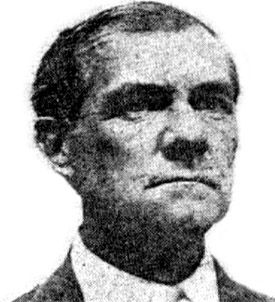Edwin Stephenson
Edwin Roscoe Stephenson (born 1870 in Georgia; died August 4, 1956 in Birmingham) was a barber, Methodist minister, and the murderer of James Coyle, pastor of St Paul's Catholic Church, in 1921.
Early life and career
Stephenson was one of five children of Confederate veteran William Franklin Stephenson of Heflin, Alabama. Born in Georgia, he had moved with his family to Alabama in 1882. He had participated in the lynching of a black man accused of rape in Cedartown, Georgia in 1904. He was ordained a local deacon by Bishop William W. Dunn in Newnan, Georgia a year later. He arrived in Birmingham in 1909 with his wife, Mary and young daughter, Ruth. They moved into a house at 2231 3rd Avenue North. He walked every day to work at a barber shop around the corner on 22nd Street.
One day about 1918, while Stephenson was cleaning a pistol, he accidently shot himself in the foot, and was thereafter unable to stand long days at the barber's chair. He exaggerated his credentials as a minister and began spending his days at the Jefferson County Courthouse, just down the street, offering to marry newly-licensed couples right there in the hallway for a small fee.
Stephenson's new vocation came to the attention of his pastor, Robert Echols of First Methodist Church, in 1920. He forced Stephenson to choose between ceasing the practice, or leaving the church. Stephenson chose the latter, moving from the Methodist Episcopal Church, South to the MEC North, leaving the church still attended by his father (who had moved to Birmingham after he became a widower in 1919) and a sister, Alice Danforth.
Murder of Coyle
About that time, Stephenson had joined the Robert E. Lee Klavern No. 1, Alabama's chapter of the revived ("Second") Ku Klux Klan, which had renewed itself at Stone Mountain, Georgia in 1915. Stephenson was a believer in the nativist's paranoid claims about the evil workings of the Catholic Church and was especially fearful for his only child, Ruth, who had showed interest in the Catholic faith from childhood. He had once ordered her off the porch of St Paul's Rectory when he found her there chatting with Father Coyle and punished her repeatedly for her flirtations with Catholicism.
On the afternoon of August 11, 1921 Stephenson learned that his daughter had not come back from lunch break to her job as a sales clerk at Loveman, Joseph & Loeb. He may also have learned of her marriage from his nephew, Ross Campbell, who answered the phone at the house while he stalked the streets looking for her. A little after 6:30 PM, Stephenson walked up to the rectory porch, confronted Coyle, and shot him three times. The priest died at St Vincent's Hospital soon later. Stephenson, whose crime had been witnessed by numerous bystanders, walked slowly across the lawn to the courthouse stair, where he was apprehended and jailed. In the hours following, he concocted a tale of self-defense, saying that Coyle had called him to the porch to taunt him about his daughter's marriage and then went inside for a moment before returning and striking him. No witnesses could testify to having seen or heard any fighting before the shots, and no other weapon was found at the scene.
Trial and aftermath
During a preliminary hearing, Ruth testified against her father, describing his hatred of Catholics, his severe punishments, and his threats against Coyle. Observers from the press painted an unsympathetic picture of the "disloyal" daughter. In the trial that followed in October, Stephenson's defense team, led by attorney Hugo Black and paid with funds raised by the True Americans and the Ku Klux Klan, added "temporary insanity" to the defense claims, exploiting the sympathies of an all white male jury for a man plagued by a disobedient daughter and horrified to suddenly learn that she had married a Puerto Rican Catholic laborer twenty years her senior. The jury accepted that explanation. He was acquitted on October 21 and sent home. He had moved shortly before the trial to 2126 7th Avenue North.
Stephenson was never reunited with his daughter. He continued to marry runaway couples at the Jefferson County Courthouse. He died in Birmingham in 1956. His crime and subsequent acquittal have remained important object lessons in the dangers of intolerant societies. The murder was fictionalized in 2004 by Joe Schrantz and the legal and social context of the crime was analyzed in the 2009 book Rising Road: A True Tale of Love, Race, and Religion in America by Ohio State University law professor Sharon Davies.
References
- Davies, Sharon (2009) Rising Road:A True Tale of Love, Race, and Religion in America. New York, New York: Oxford University Press ISBN 0195379799
